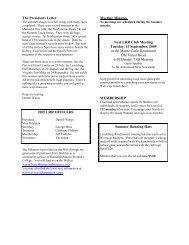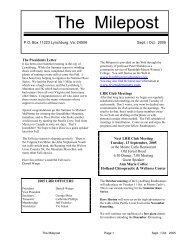Destinos: 27-52 The Main Grammar Points, and Exercises with ...
Destinos: 27-52 The Main Grammar Points, and Exercises with ...
Destinos: 27-52 The Main Grammar Points, and Exercises with ...
Create successful ePaper yourself
Turn your PDF publications into a flip-book with our unique Google optimized e-Paper software.
19<br />
(which means that our arriving was a real fact when they called). Likewise in numbers 2 <strong>and</strong> 3<br />
they had eaten before we left, <strong>and</strong> so, again, the answer is YES (their eating occurred before our<br />
leaving). In number 4, however, their eating was not an accomplished fact before the action in the<br />
independent clause (our leaving) occurred, so for number 4 the answer to this second question is<br />
NO.<br />
As you might expect, we shall use the indicative mood for the verb in the dependent adverbial<br />
time clauses in 1, 2, <strong>and</strong> 3, but in number 4 the subjunctive will be used. In all four sentences, the<br />
tense--regardless of whether the mood is indicative or subjunctive--will be a past tense. Here are<br />
the four sentences in Spanish; the dependent adverbial clauses have been underlined, <strong>and</strong> the<br />
mood <strong>and</strong> tense of the verb in the dependent clause have been indicated:<br />
1. Llamaron cu<strong>and</strong>o llegamos. (indicative-past tense)<br />
2. Tan pronto como comieron, salimos. (indicative-past tense)<br />
3. Salimos después (de) que comieron. (indicative-past tense)<br />
4. Salimos antes (de) que comieran. (subjunctive-past tense)<br />
IV. COMMANDS<br />
Overview.<br />
<strong>The</strong>re are comm<strong>and</strong>s, or imperatives, for five forms in Spanish: tú, Ud., nosotras/os, vosotros/as,<br />
<strong>and</strong> Uds. <strong>The</strong> <strong>Destinos</strong> program covers only tú, Ud, <strong>and</strong> Uds. comm<strong>and</strong> forms. <strong>The</strong> formation of<br />
affirmative tú comm<strong>and</strong>s sets this form apart, but there are still some general grammatical rules<br />
which apply to all comm<strong>and</strong> forms. <strong>The</strong>se common rules will be repeated as we consider the<br />
various comm<strong>and</strong>s individually, but it will be useful to set them out here as well, before we begin<br />
<strong>with</strong> the separate forms. Subsequent examples will make these rules clear.<br />
1. Object pronouns (including reflexives), are attached to affirmative comm<strong>and</strong>s, but<br />
precede negative comm<strong>and</strong>s.<br />
2. All negative comm<strong>and</strong>s are forms of the present tense of the subjunctive mood.<br />
A. USTED comm<strong>and</strong> forms.<br />
<strong>The</strong> affirmative <strong>and</strong> negative Ud. comm<strong>and</strong> forms are the same. <strong>The</strong>y are identical to the third<br />
person singular (=Ud.) form of the present subjunctive:<br />
Examples: HABLAR-(no) hable Ud.; COMER-(no) coma Ud. ; VIVIR-(no) viva Ud.;<br />
TENER-(no) tenga Ud.; SER (no) sea Ud.; CONDUCIR- (no) conduzca Ud., etc.<br />
Remember that certain verbs reflect orthographic, or spelling, changes in the subjunctive:<br />
examples are BUSCAR-busque; PAGAR-pague; SEGUIR-siga; ALMORZAR-almuerce,<br />
etc.



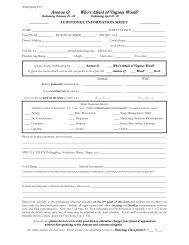
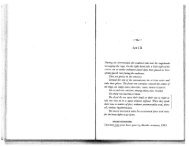
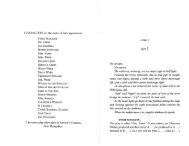
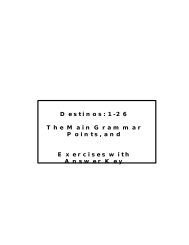
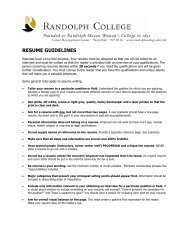
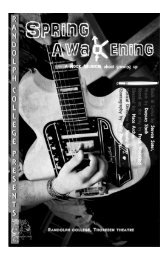
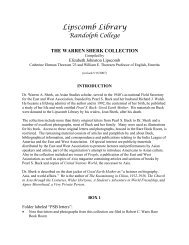
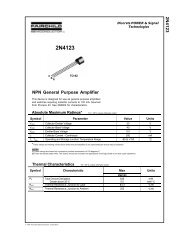

![Cast & Crew List [Program Copy pdf] - Randolph College](https://img.yumpu.com/38268916/1/190x123/cast-crew-list-program-copy-pdf-randolph-college.jpg?quality=85)

